Image scans and photographs by the author. [You may use these images without prior permission for any scholarly or educational purpose as long as you (1) credit the photographer and (2) link your document to this URL or credit the Victorian Web in a print one. Click on the images to enlarge them.]

Grand Chapter of the Star of India at Calcutta, 1 January 1876. The Prince of Wales investing the Maharajah of Joodphore [Jodhpur] with the Order. Source: Tinted engraving from the collection of the Imperial Hotel, Janpath, New Delhi, reproduced by kind permission of the hotel. This was one of the many highlights of the trip, and perhaps the picture that has been reproduced most often.
Bombay and Environs
Prince Albert Edward (Bertie), Queen Victoria's eldest son, set sail from London on 11 October 1875 on the royal ship HMS Serapis, and arrived at Bombay in India just under a month later, on 8 November. There were altogether fifty men in the party, the next highest ranking to the Prince being the Duke of Sutherland, followed by Sir Bartle Frere. Chosen to record the visit were the Prince's Honorary Private Secretary, William Howard Russell (1820-1907), who reported on it for the Times, and the artist Sydney P. Hall (1842-1922), who was responsible for the illustrations in Russell's subsequent book about it. During the next seventeen weeks the Prince made an extensive tour of the country, meeting the colonial elite, being entertained in style by the native princes, bestowing honours, attending functions of all kinds, receiving costly gifts, participating in animal shoots and sporting events, dallying with one or two English belles, and so on. As Russell would note later, by the time he left, the Prince knew "more Chiefs than all the Viceroys and Governors together and [had] seen more of the country ... than any living man" (521). The tour was as extensively covered at home as it was extensive, but it is not much discussed now. Yet it demonstrated the surprising strengths of the future Edward VII, and had very significant repercussions for the Raj.

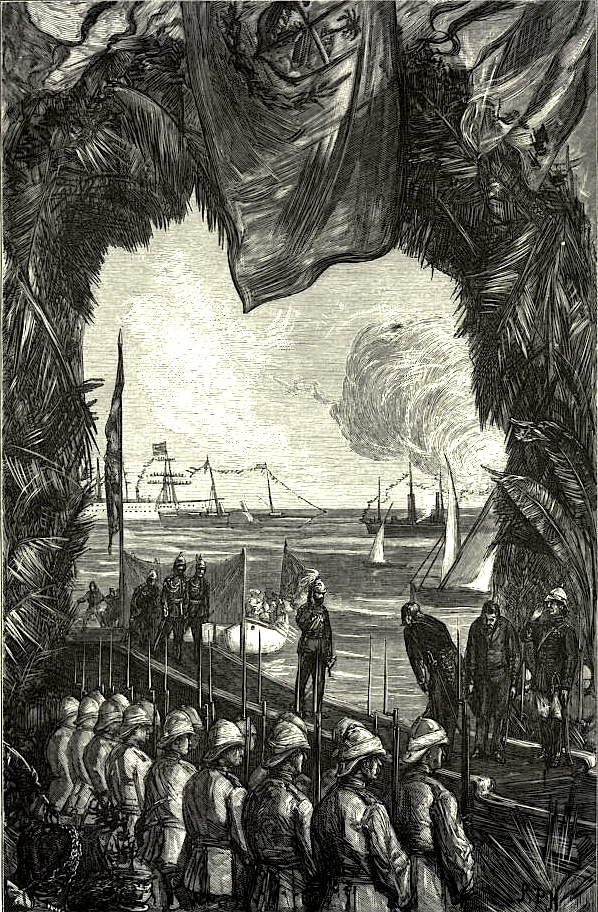
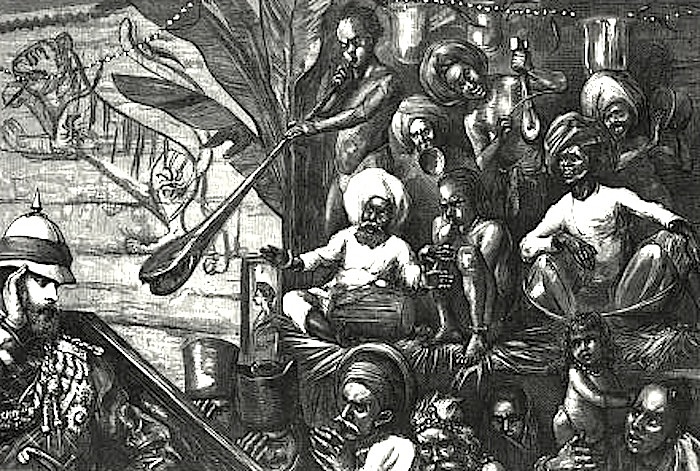
Left to right: (a) Sketch Map to Illustrate the Tour of HRH The Prince of Wales. Source: Russell, facing p. 1. (b) The First Step on Indian Soil: Landing at Bombay. Source: Russell, facing p. 115. (c) Shamzadan [Crown Prince] Passes! Native Band at Poonah. Source: Russell, facing p. 180.
Having acquitted himself well at his first royal audience in Bombay, the Prince then made it his base for some side trips into the neighbouring areas. First, he went eastwards by train for Poona, almost 120 miles away, making the scenic ascent of the Bhore Ghat, that had been such a massive feat of railway engineering, on the way. Poona (present-day Pune) was a cantonment area and the summer residency of the Governor of Bombay. Then, having been very handsomely received, presented with many gifts from rajahs and heads of state, and taken his first elephant ride, the prince returned to Bombay briefly before setting again on another scenic train trip, several times further and towards the north this time, across various bridges over rivers and estuaries, to the princely state of Baroda. On 18 November the special train was met at Baroda station by the thirteen-year-old Gaekwor of Baroda, who had already gone to greet the Prince in Bombay. Two days later, the Prince was off for his first shooting event or shikar. It was the beginning of a veritable orgy of such big-game hunting expeditions. This particular visit included a form of entertainment that the young Gaekwor particularly enjoyed: animal fights, between elephants, rhinos, and rams, and this caused some comment at home. The Aberdeen Journal perhaps struck the right note, acknowledging their brutality, but pointing out that the Prince was "not there to run amuck at anything that offends his more humane sensibilities," adding (surely correctly) that his hosts "were doing their best, from the highest to the lowest, to welcome him after their fashion." There is no hint, however, that the Prince's sensibilities were affected!
South to Ceylon, and up to Madras
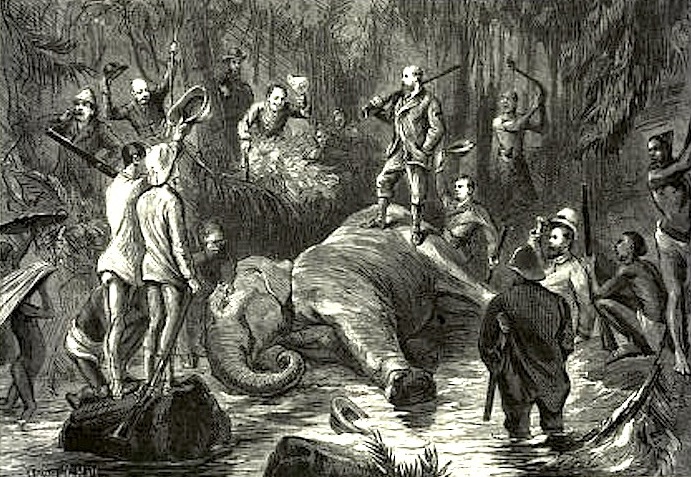
Ceylon — The Dead Elephant. Source: Russell, facing p. 283.
On his return to Bombay, the Prince set off by the royal ship Serapis again, on a voyage to South India, first along the western coast, stopping on the way at Goa and the historic port of Beypore in Kerala. From there the Serapis sailed to Ceylon (present-day Sri Lanka), where the Duke of Sutherland surprised their hosts with his engineering skills, driving the royal train "round that dizzy promontory the 'Sensation Rock.'" At some point he also tightened up a coupling "with all the skill and proper application of strength" (Wheeler 12). The Prince proved himself in a more predictable and indeed expected way, by performing well in a particularly bloody and triumphalist elephant shoot. This again provoked controversy in the British press, understandably so, because elephant-hunting had only recently been banned by the colonial government (see "Elephants in Ceylon"). But it served to confirm his princely status: "Shooting an elephant was a public act, a performance where the prince was a principal actor: he must be seen to kill the great beast" (Ridley 177-78).
This great loop of the subcontinent was less than halfway through. Returning to India, the Prince and his party set off again by train to Madurai in Tamil Nadu, at the start of a rail journey that took them up 82 miles up the eastern coast to Trichinoploy (Tiruchchirapalli), and a further 198 miles to Madras, their main stop on the way to the seat of the Raj, at Calcutta. Their reception at Madras was again phenomenal:
As they packed themselves together to await the coming of the Prince, the women grouped by hundreds, the men in similar numbers, the front rank seated on the ground, those behind kneeling, while the rearmost of all stood up and peered over the heads of the others, they formed a vast and far-extending mass, to see which a journey of even eleven thousand miles was not too much. Every now and then carriages containing Bajahs and Maharajahs is picturesque costumes, escorted by the Governor's bodyguard in bright scarlet and gold uniforms, and followed by parties of their own wild-looking horsemen, drove past; and at last the Prince himself came, cheered vociferously by the crowd. [Gay 162]
The days in Madras were crammed with sight-seeing, and included a spectacular late night entertainment — one so late, in fact, the the prince himself only arrived at midnight.
Calcutta to Benares, via Bankipur
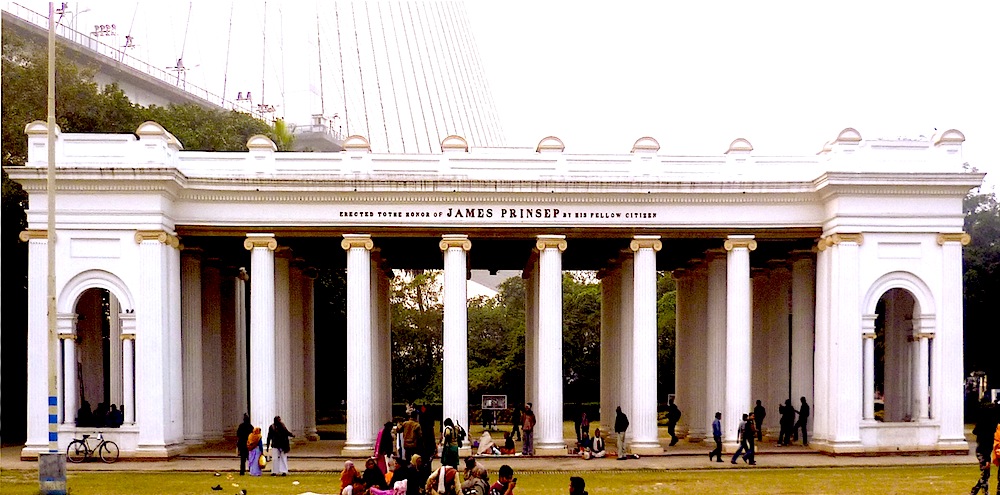
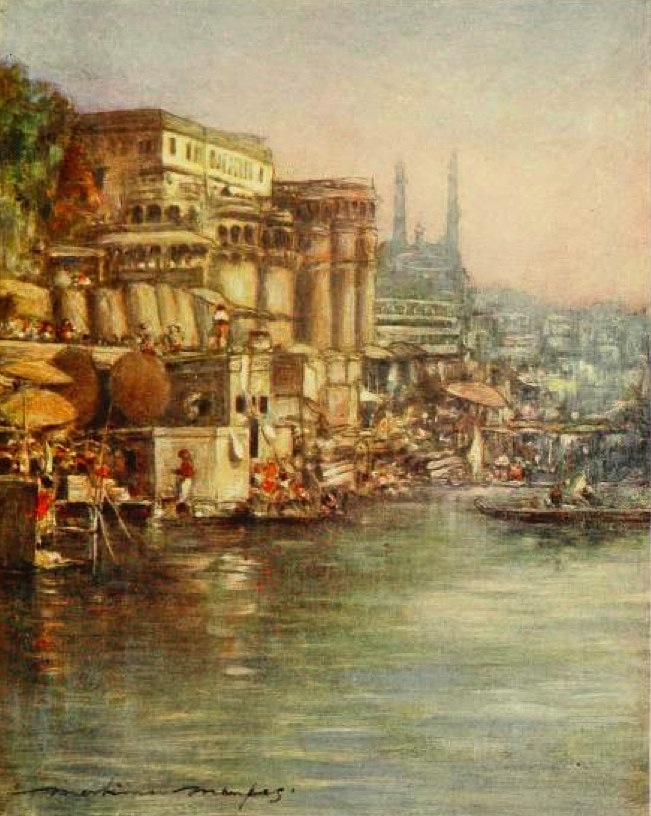
Left: Prinsep Ghat. Designed by W. Fitzgerald, this striking ionic landing stage on the Hooghly River at Calcutta was built in memory of James Prinsep (1799-1840), the eminent Oriental scholar, in 1843. It has recently been restored. Right: Benares. Illustration by Mortimer Menpes. Source: Finnemore, facing p.48.
The Prince of Wales finally arrived in Calcutta, the seat of the Raj, on 23 December. Here he stayed at the Raj Bhavan, and was able to attend the Christmas Day service at St Paul's Cathedral, before being conveyed to Prinsep Ghat, where huge crowds had gathered to see the flag-bedecked Serapis and catch a glimpse of the Prince himself. Thence the royal party went by river on the short trip to the French settlement of Chandernagore (present-day Chanannagar, just north of Kolkata) before the Serapis docked at Prinsep Ghat again. After the next few busy days in Calcutta, the Chapter of the Order of the Star of India was held on New Year's Day, with the prince dispensing honours, including knighthoods, to various Maharajas and high ranking officials. On 3 January, the prince received an honour himself: he was made honorary Doctor of Laws at Calcutta University (Wheeler 218).
Then he was off again, on the next leg of a tour which took him by train and boat along the Ganges. At the next stop, Bankipoor (now Bankipur) in Patna, Bihar, on the southern bank of the Ganges, he was met by Sir Richard Temple, and all the officials of the district, along with troops, police and crowds of onlookers. Although this was no princely state, again, the reception was extravagant:
Sir Richard Temple had made preparations to show what a Lieutenant-Governor of Bengal could do. His Court, if not equal in splendour to that of the Viceroy, satisfied the spectator that he was a satrap [ruler] of no ordinary magnitude and magnificence.... Considering that there are, it is said, less than 100,000 Europeans in India, it was surprising to see what an assembly of ladies, in the most charming bonnets and most correct costumes, were waiting to welcome him. The avenue to the Durbar tent was lined by nearly four hundred elephants, caparisoned with great richness, the howdahs filled with people in gala dresses. The great multitude Europeans on one side of the way and natives on the other was loyal and picturesque; the loyalty of the Europeans expressed by cheers, waving of handkerchiefs, playing of bands, and discharges of cannon; the picturesqueness afforded by Rajas, Nawabs, and natives of inferior dignity. [Russell 382]
All this, however, just for a three-hour break, after which the Prince returned to the railway station, and then travelled on to the holy city of Benares, with its spectacular ghat and its unforgettably palatial background. Another lavish reception awaited him from the Maharajah there. The Daily Telegraph correspondent realised how much this place would mean to "a believer in Shiva, a red-turbaned, shuffling, white-petticoated, olive-coloured native of Hindostan, with his heart set upon visiting the sacred city of India," and knew that such a one "would leap for joy; would forget the mist and the dimness, the chilly wind and clammy air, the chance of having no bed, and possibly no board either, and rejoice with exceeding joy at the prospect of plunging in the Ganges next morning, and washing away what peccadilloes and worse might cling to his soul" (Gay 218). But from his own description, it is clear that this observer did not quite share the enthusiasm, and had no intention whatsoever of dipping into a river which "might, were it not so sacred, be called very dirty" (220). It is remarkable that the Prince and his party not only kept up the pace set for them by the India Office at home, but also managed (apart from some knocks in a pig-sticking event and the Prince's catching a cold in Calcutta) to avoid its health hazards.
Lucknow and Kanpur
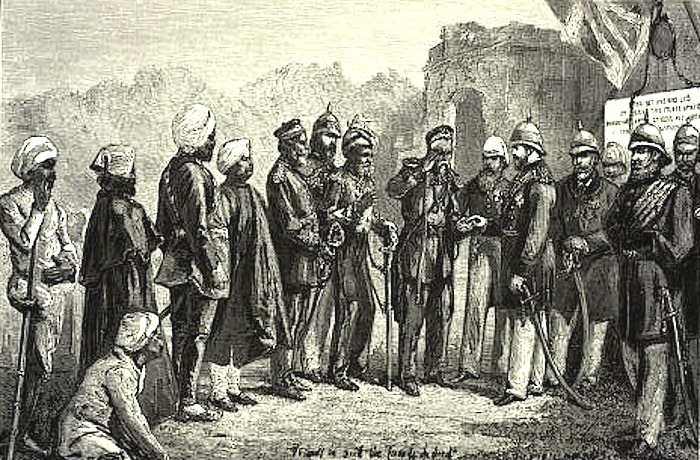
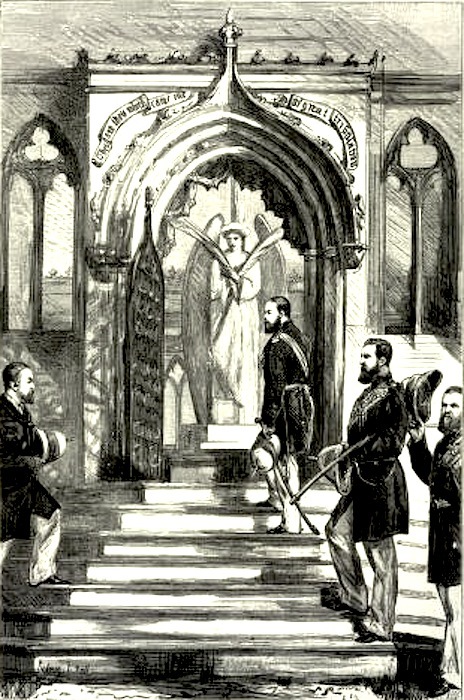
Left to right: (a) Veterans at Lucknow. Source: Russell, facing p. 393. (b) Visit to the Cawnpore Memorial. Source: Russell, facing p. 401.
The stop at Lucknow was special. Here, the element of gorgeous and spectacular entertainment gave way to poignant and stirring memories of the famous siege and its relief, during the 1857 Mutiny. A Celtic cross had long since been raised in the Residency garden in memory of Sir Henry Lawrence and the European officers and men who died then; now the Prince laid the first stone of a monument outside the garden, to the Indians who also died with them. It was surely the most emotional ceremony in which the Prince took part in India. In the presence of the assembled troops, the English flag was raised outside the battle-scarred ruins of the old Residency. Trumpets sounded, salutes were made, drums rolled and cannon fired.
The salute over, the Prince desired that all the survivors of the defence might be presented to him. The picture... was touching in the extreme. Some two hundred old warriors filed past. First came the officers.... They were followed by sixteen native officers and non-commissioned officers who had taken part.... and lastly, and on which all eyes turned, was a mixed band of decrepit warriors, and young men who, as mere boys, had done their duty nobly within the walls.... In some cases their bodies were supported by friends, and their palsied arms were with difficulty made to give a last salute.... Several veterans came forward in the old stiff uniforms of the East India Company's service, and having swords covered with the rust of twenty years. During the scene, many ladies, some of whom had lost sons in the relief, were in tears. Every one was affected. [Wheeler 227-28]
The Chief Commissioner for the region of Oude (present-day Awadh) declared, in the speech that followed, that the behaviour of the sepoys at Lucknow, who voluntarily stood by the British during the siege, "was simply without a parallel in the annals of the world" (qtd. in Wheeler 228). Amongst the other sights that the Prince was shown in Lucknow was the "square grey tomb, with a shelving stone on the top" of Major Hodson, whose elaborately carved monument can be seen in Lichfield Cathedral.
The royal party then set off for Delhi, with a couple of hours' pause in the evening at Cawnpoor (now Kanpur), where the Prince paid his respects at the spot of perhaps the most notorious of the atrocities committed during 1857 on both sides, when two hundred or so British women and children were butchered and thrown into a well (for an objective assessment, see Keay 442). Here stood Baron Marochetti's The Angel of Pity memorial. Marochetti loved to design and sculpt angels, and this is one of his finest. "I cannot describe the effect of the bright moon's rays on the white marble work — or how the whole memorial stood out in its lonely grandeur on that delightful night," wrote a member of the party (Gay 237-38). The Prince also inspected the Memorial Gardens and the only recently completed church there, now called the Kanpur Memorial Church, to which the monument has since been moved.
Delhi
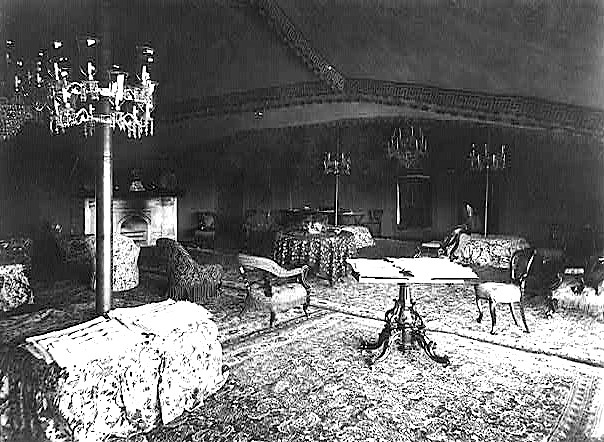
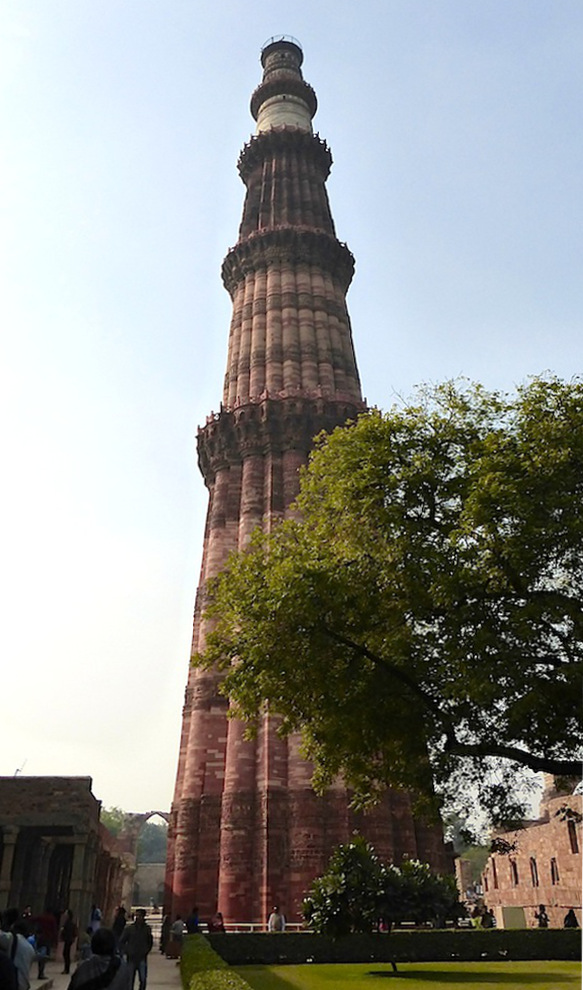
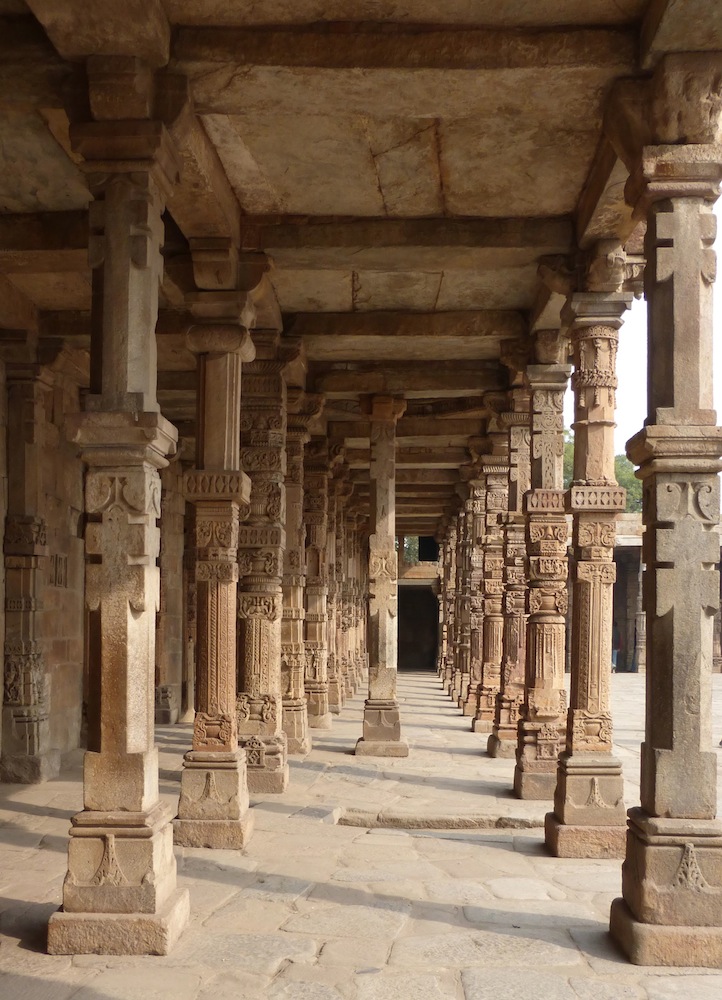
Left to Right: (a) Interior of the Royal Drawing Room Tent in Delhi. Source: black & white film copy neg. Library of Congress Digital Image, reproduction no. LC-USZ62-67684. (b) The Qtab Minar, a victory tower with twelfth-century origins, leans slightly now, and it is no longer possible to climb up it, as the Prince did. (c) Ruins of the Quwwat-ul-Islam Masjid in the complex, also of twelfth-century origin.
Travelling overnight by train, the royal party reached Delhi on 11 January, where they spent six days. There was the usual tremendous welcome, and again the visit was imbued with memories of 1857: most of the activities during the stay were of a military nature. As they had done at Benares, the guests stayed under canvas, and again in considerable luxury. The Prince's tents in particular were splendidly appointed: "The camp was a more luxurious bivouac than any monarch sleeping in the tented field has ever enjoyed" (Wheeler 235). There was a levee, followed by a glittering review of both British and Indian regiments, with the Prince sporting the uniform of a Field Marshal, and extensive military manoeuvres, with the Prince himself taking part on a charger. But amid all this there was still time for entertainment of a gentler kind, and some sightseeing:
At the Kootab there was a small camp pitched for the occasion. There was a military band, and lunch was laid in a large marquee. Many ladies were invited from Delhi. The Prince mounted to the summit of the Kootab, said to be the highest pillar in the world (it measures 238 feet in height), and viewed the wide-spread ruins of forts, tombs, mosques, and cities. [Russell 414]
It is easy to see, from the various accounts of the Prince's stay here, how Delhi, with its long and fascinating history, more recent associations for the British, and excellent railway connections, later came to be chosen as the capital of the Raj.
It is equally easy to see how the glowing reports of Bertie's triumphal progress up to this point played on the Queen's desire to be called Empress of India. As for the Prince himself, indefatigable, keen to engage in the pageantry of every occasion, appreciative of and sympathetic towards the Indian princes and colonial representatives alike, responsive to the common people as well, he was proving to be a wonderful ambassador for the British crown. The Queen's next move was not something he himself foresaw or wanted: "I could never consent to the word 'Imperial' being added to my name," he told Disraeli (qtd. in Ridley 181). Nor was he even consulted about it (see Ridley 181). But exactly a month after the royal party left Delhi on the next leg of their tour, Disraeli was putting forward to Parliament the Royal Titles Bill.
Related Material
- Part II: From Delhi to Bombay
- The Qtub Minar and the Victorians
- The 1857 Indian Mutiny (also known as the Sepoy Rebellion, the Great Mutiny, and the Revolt of 1857)
- Royal Titles Bill (Second reading)
- New Crowns for Old Ones (John Tenniel's cartoon lampooning the Royal Titles Bill)
Sources
Bisht, B. M. S., ed. "Titbits from my Archives: The Prince of Wales' Railway Journeys in India, 1875-1876" (edited and clearly dated excerpts from Russell, giving a good idea of the tour in brief). IRFCA (Indian Railways Fanclub). Web. 30 March 2014.
"Elephants in Ceylon." The Times. 25 May 1875: 11.
Finnemore, John . Peeps at Many Lands: India. Illustrated by Mortimer Menpes. London: Adam and Charles Black, 1910. Internet Archive. Web. 30 March 2014.
Gay, J. Drew. The Prince of Wales in India, or From Pall Mall to the Punjaub. New York: R. Worthington, 1877. Internet Archive. Web. 30 March 2014.
Keay, John. A History of India. Pbk ed. London: HarperCollins, 2001.
"The Prince of Wales in India." The Aberdeen Journal. 24 November 1875: 3. 19th Century British Newspapers (Gale). 30 March 2014.
Ridley, Jane. Bertie: A Life of Edward VII. London: Chatto & Windus, 2012.
Russell, William Howard, Sir. The Prince of Wales' Tour: A Diary in India; with some account of the visits of His Royal Highness to the courts of Greece, Egypt, Spain, and Portugal. 2nd ed. London: Sampson Low, Marston, Searle and Rivington, 1877.Internet Archive. Web. 30 March 2014.
Spear, Percival. A History of India: Vol. II: From the Sixteenth Century to the Twentieth Century. New Delhi: Penguin Books India, 1990.
Wheeler, George. India in 1875-76: The visit of the Prince of Wales: Chronicle of His Royal Highness's Journeying in India, Ceylon, Spain and Portugal. London: Chapman and Hall, 1876. Internet Archive. Web. 30 March 2014.
Last modified 30 March 2014